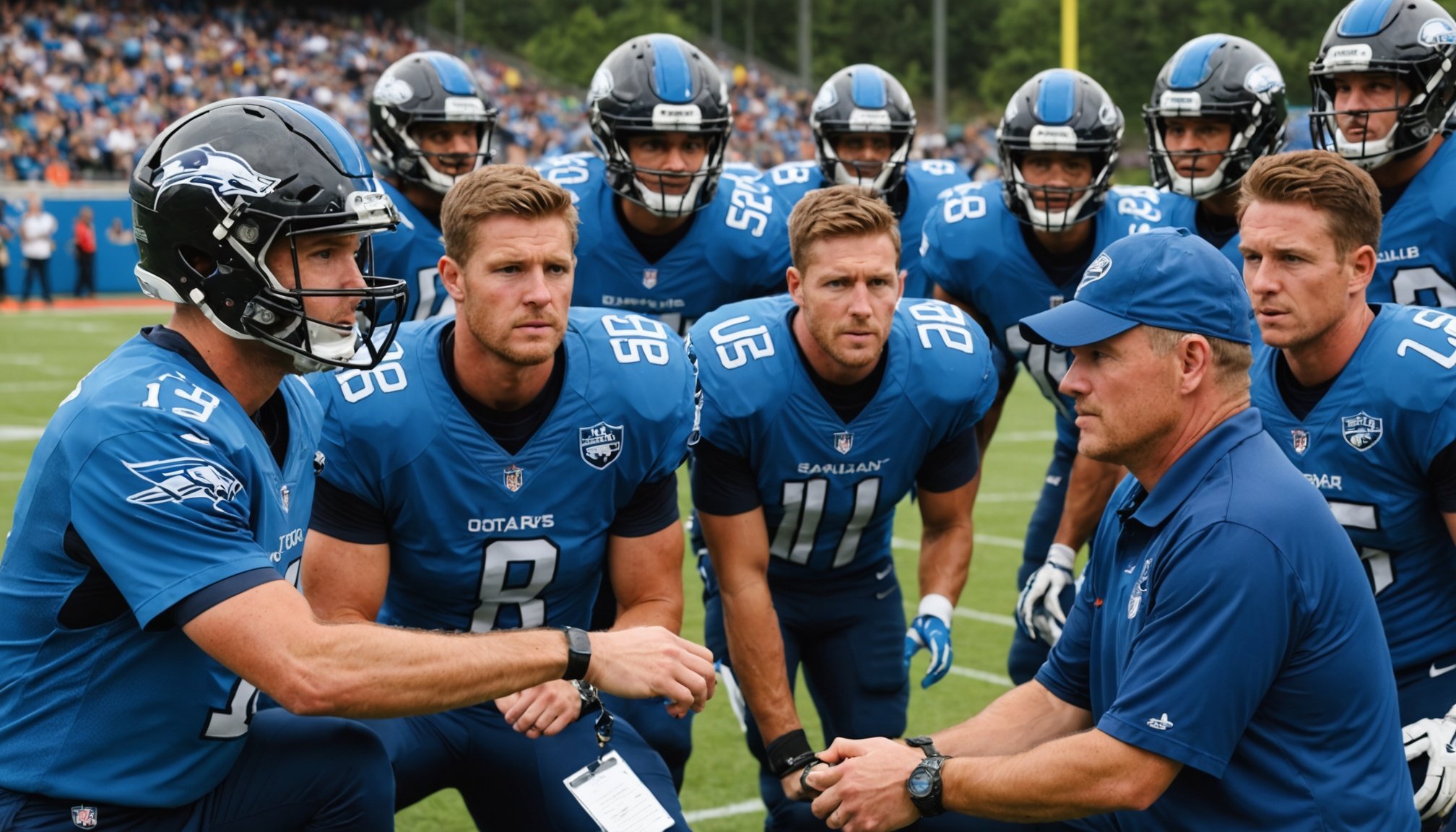Unlocking Squad Rotation Secrets: Essential Strategies for Football Coaches Tackling Packed Fixture Schedules
Managing a football team through a packed fixture schedule is one of the most challenging tasks a coach can face. With multiple games in a short span, the risk of player fatigue, injuries, and decreased performance is ever-present. One of the key strategies to mitigate these risks is squad rotation. Here, we will delve into the intricacies of squad rotation, exploring why it is crucial, how to implement it effectively, and the tools and analytics that can support this strategy.
Understanding the Importance of Squad Rotation
Squad rotation is not just about giving rest to key players; it is a comprehensive tactical approach that ensures the team remains competitive throughout the season. Here are a few reasons why squad rotation is essential:
Topic to read : Enhancing football match days: unlocking fan insights for unforgettable club experiences
Reducing Player Fatigue
Player fatigue is a significant concern during a packed fixture schedule. Continuous play without adequate rest can lead to decreased performance, increased risk of injuries, and mental health issues. By rotating the squad, coaches can ensure that players get the necessary rest and recovery time, maintaining their physical and mental well-being[3].
Maintaining Team Cohesion
Rotating the squad does not mean disrupting team cohesion. Instead, it allows coaches to test different combinations of players, fostering a deeper understanding among team members. This approach can enhance communication, trust, and overall team dynamics, which are critical for success in football[5].
This might interest you : Strengthening local bonds: innovative approaches for football clubs to enhance community involvement and growth
Developing Young Players
Squad rotation provides an excellent opportunity to integrate young players into the first team. By giving them game time, coaches can assess their readiness, develop their skills, and prepare them for more significant roles in the future. This not only strengthens the team’s depth but also motivates young players, boosting their morale and engagement[3].
Types of Squad Rotations
Squad rotations can be implemented in various ways, depending on the team’s needs and the specific game scenario.
Tactical Rotations
Tactical rotations involve changing the starting lineup to adapt to different opponents or game situations. For example, Inter Milan manager Simone Inzaghi might bench several first-team stars to rest them and bring in fresh players who can offer a different tactical approach against a specific opponent[3].
Example: Inter Milan vs. Bayer Leverkusen
In a recent UEFA Champions League game, Inzaghi considered heavy squad rotations, including benching out-of-form captain Lautaro Martinez and bringing in players like Davide Frattesi and Piotr Zielinski. This tactical move was aimed at refreshing the team’s attack and defense while also giving key players a much-needed rest.
Positional Rotations
Positional rotations involve players switching roles within the same game or between games. This can be seen in the use of rotations in football tactics, where players move into different positions to create confusion for the opposition and open up new attacking opportunities.
Example: Wide Rotations
In wide rotations, a winger might cut inside to occupy the half-space, while the fullback overlaps to provide width. This movement creates confusion for defenders and opens up crossing or shooting opportunities. For instance, if a team is facing a compact defense, wide rotations can help in breaking down the opposition by creating unpredictable movements[1].
Implementing Squad Rotations Effectively
Implementing squad rotations is not a simple task; it requires careful planning, communication, and practice.
Player Awareness and Communication
Players must understand the purpose of rotations and know when and where to move. This requires excellent communication, spatial awareness, and a deep understanding of the team’s tactical setup. Coaches should ensure that players are aware of their roles and the expected outcomes of these rotations[1].
Positioning and Balance
Rotations should enhance the team’s structure rather than disrupt it. Players must ensure that the team maintains balance, especially during transitions. For example, if a fullback pushes forward, a midfielder or center-back should be ready to cover defensively. This balance is crucial for maintaining defensive stability while allowing the team to apply pressure on the ball[1].
Timing and Coordination
The timing of rotations is crucial. Poorly timed movements can lead to turnovers and leave the team vulnerable to counterattacks. Precise execution and coordination among players are vital for this tactic to be effective. Coaches should use training sessions to practice these movements, ensuring that players execute them instinctively during matches[1].
The Role of Advanced Football Analytics
Advanced football analytics play a pivotal role in supporting squad rotation strategies. Here’s how analytics can help:
In-Game Tactical Adjustments
Real-time data analysis provides coaches with actionable insights during matches, allowing them to make strategic adjustments. For example, player tracking data can indicate fatigue or underperformance, prompting timely substitutions to maintain energy levels and tactical effectiveness. Heat maps and player positioning data can reveal gaps or inefficiencies in the current setup, enabling coaches to tweak formations on the fly to counter opponents[2].
Example: Using Expected Goals (xG)
Metrics like Expected Goals (xG) can help coaches evaluate the quality of scoring opportunities and make informed decisions about player rotations. If a player is not creating high-quality chances, it might be time to bring in a fresh attacker who can offer a different threat.
Opponent Analysis
Advanced analytics enable teams to study opponents in detail, uncovering weaknesses and patterns that can be exploited. By analyzing defensive structures and pressing intensity, coaches can identify areas to penetrate and plan their rotations accordingly. For instance, metrics like Passes Allowed Per Defensive Action (PPDA) can measure the effectiveness of an opponent’s pressing, helping coaches to decide how to bypass their defensive lines[2].
Team and Player Performance Optimization
Analytics help teams fine-tune overall performance by optimizing player roles and managing stamina. GPS tracking data highlights player workloads, enabling coaches to adjust training and match-time responsibilities to prevent burnout. Metrics such as xPass and pressing efficiency help assign players to roles where they can maximize their strengths, whether in defense, midfield, or attack[2].
Practical Insights and Actionable Advice
Here are some practical tips for coaches looking to implement effective squad rotations:
-
Train Regularly: Rotations must be practiced regularly in training sessions. Use small-sided games, positional drills, and match simulations to help players develop the movement patterns needed for effective rotations. Repetition is key to ensuring that players execute these movements instinctively during matches[1].
-
Be Flexible: Rotations should be flexible and adaptable to different game scenarios. Coaches should encourage players to read the game and adjust their movements based on the opposition’s defensive setup[1].
-
Use Data-Driven Insights: Leverage advanced football analytics to make informed decisions about player rotations. Use metrics like xG, PPDA, and heat maps to understand player performance and opponent weaknesses[2].
-
Maintain Communication: Ensure that all players are aware of their roles and the expected outcomes of the rotations. Clear communication is crucial for maintaining team cohesion and ensuring that rotations are executed smoothly[1].
Case Study: PSV Eindhoven’s Training Methods
PSV Eindhoven is known for its innovative training methods, which include detailed drills that mimic real-game scenarios. Here’s how PSV approaches training to support squad rotations:
-
Rondos in Rectangles: Unlike traditional rondos played in squares, PSV uses rectangles to create more realistic and challenging scenarios. This shape forces players to think more critically about space and movement, preparing them for the complexities of actual games[4].
-
Individual Feedback: PSV coaches provide individual feedback during training sessions, ensuring that players understand their specific roles and areas for improvement. This personalized approach helps in developing a more cohesive and adaptable team[4].
Squad rotation is a vital strategy for football coaches navigating packed fixture schedules. By understanding the importance of reducing player fatigue, maintaining team cohesion, and developing young players, coaches can make informed decisions that enhance their team’s performance.
Through the use of advanced football analytics, tactical planning, and extensive practice, coaches can implement squad rotations effectively. Here is a summary of the key points:
Key Takeaways
- Reduce Player Fatigue: Give players adequate rest to prevent injuries and maintain performance.
- Maintain Team Cohesion: Ensure that rotations do not disrupt team dynamics but rather enhance communication and trust.
- Develop Young Players: Use rotations to integrate young players into the first team.
- Use Advanced Analytics: Leverage metrics like xG, PPDA, and heat maps to make data-driven decisions.
- Practice Regularly: Train rotations in various game scenarios to ensure smooth execution.
- Be Flexible: Adapt rotations based on the opposition’s defensive setup.
By mastering these strategies, football coaches can unlock the full potential of their teams, ensuring they remain competitive and successful throughout the season.
Detailed Bullet Point List: Steps to Implement Effective Squad Rotations
-
Assess Player Fitness:
-
Use GPS tracking data to monitor player workloads.
-
Evaluate player fatigue levels through physical and mental health assessments.
-
Analyze Opponent Weaknesses:
-
Study defensive structures and pressing intensity.
-
Identify areas to penetrate using metrics like PPDA.
-
Plan Tactical Rotations:
-
Decide on the best starting lineup based on the opponent and game scenario.
-
Prepare alternative formations and player roles.
-
Communicate with Players:
-
Ensure all players understand their roles and the expected outcomes of the rotations.
-
Provide individual feedback during training sessions.
-
Practice Rotations:
-
Use small-sided games, positional drills, and match simulations.
-
Repeat drills to ensure players execute movements instinctively.
-
Make Data-Driven Decisions:
-
Use metrics like xG to evaluate scoring opportunities.
-
Analyze heat maps to understand player positioning and movement patterns.
-
Be Adaptable:
-
Adjust rotations based on the opposition’s defensive setup.
-
Encourage players to read the game and adjust their movements accordingly.
Comprehensive Table: Comparison of Different Rotation Strategies
| Rotation Strategy | Description | Benefits | Challenges |
|---|---|---|---|
| Tactical Rotations | Changing the starting lineup to adapt to different opponents or game situations. | Allows for fresh players and different tactical approaches. | Requires careful planning and communication. |
| Positional Rotations | Players switching roles within the same game or between games. | Creates confusion for the opposition and opens up new attacking opportunities. | Demands high levels of player awareness and coordination. |
| Defensive Rotations | Rotations to cover defensive spaces when one defender steps out to press an opponent. | Ensures defensive stability while allowing the team to apply pressure on the ball. | Needs precise timing and coordination among players. |
| Advanced Analytics-Driven Rotations | Using metrics like xG, PPDA, and heat maps to make informed decisions about player rotations. | Provides data-driven insights to optimize player roles and manage stamina. | Requires access to advanced analytics tools and expertise in interpreting the data. |
By understanding and implementing these strategies, football coaches can ensure their teams remain competitive, fresh, and effective throughout the demanding fixture schedules of modern football.
















